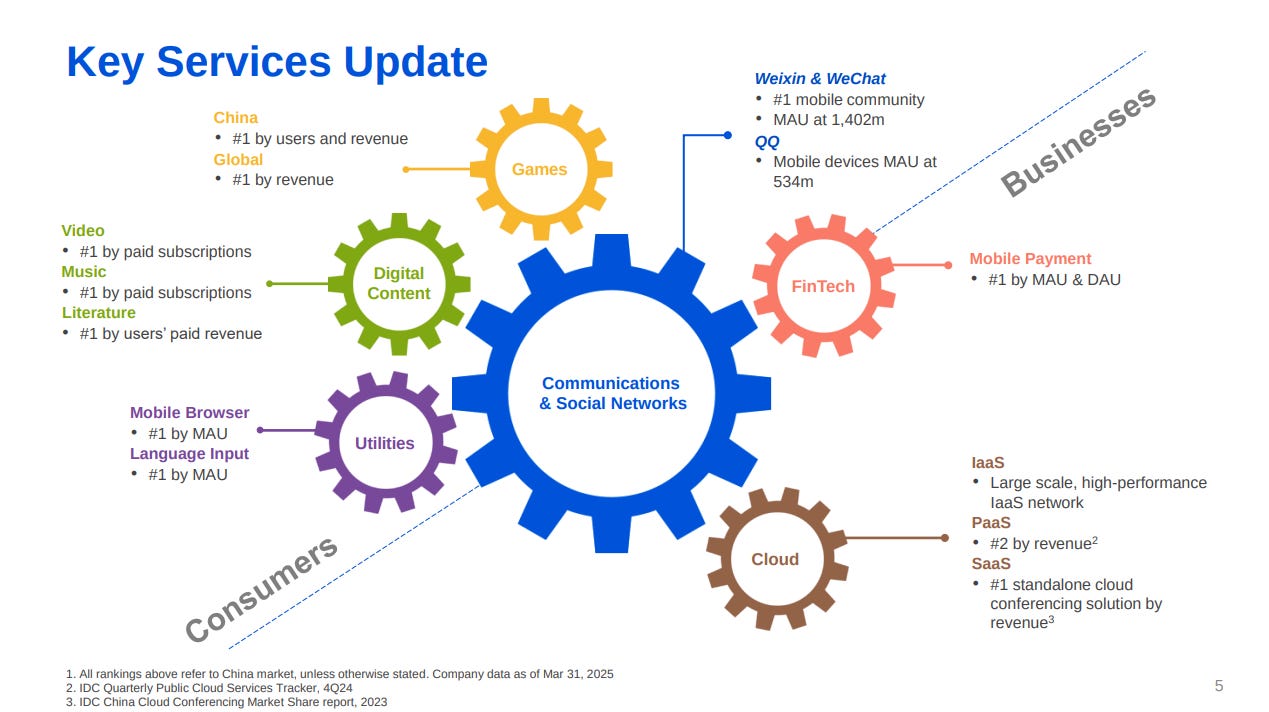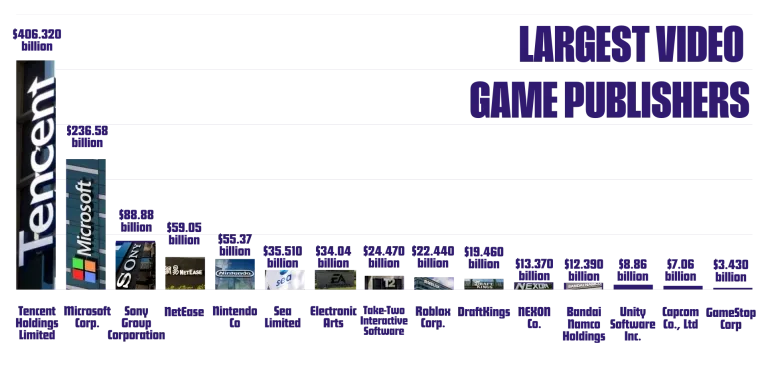Tencent One Pager
Founded in 1998 by Pony Ma and four college classmates, Tencent began as a knockoff of ICQ called OICQ. After losing a trademark lawsuit to AOL, they rebranded to QQ and stumbled into building something Western tech companies are still trying to figure out: a super app that actually works.
Ma still runs the company as CEO and Chairman with roughly 9.7% of the business, maintaining his famously secretive lifestyle. Prosus (controlled by South African media giant Naspers) owns 25.6% as the controlling shareholder, making this one of the few major Chinese tech companies with significant foreign ownership.
Operating Model: The Super-App Ecosystem
WeChat isn't just messaging – it's the digital nervous system of China. With over 1.4 billion monthly users as of early 2025, WeChat handles everything from payments to government services to ride-hailing to gaming, all within a single app.
The genius lies in "mini-programs" – lightweight apps that run inside WeChat without requiring separate downloads. Third-party businesses offer e-commerce, games, utilities, and more on the platform, while Tencent provides the infrastructure and collects fees. Think of it as owning the iPhone's home screen and taking a cut of everything that happens there.
This creates a flywheel that Silicon Valley can only fantasize about. More users attract more mini-programs, which creates more utility, which brings more users, which generates more data to improve everything. The stickiness is absurd – switching away from WeChat in China would be like voluntarily cutting off your thumbs.
Gaming Empire
While WeChat hooks users, gaming pays the bills. Tencent is the world's largest video game company by revenue, owning Riot Games (League of Legends), holding 40% of Epic Games (Fortnite), and maintaining stakes in hundreds of other studios globally.
For 2024, domestic gaming revenue grew 10% to $19.6 billion, while international gaming reached $8.1 billion. The company extended its "evergreen games" from 12 to 14 titles, reflecting how they've mastered the art of building games with staying power.
Gaming integrates beautifully with everything else. New games get instant distribution through WeChat's social graph. Players pay with WeChat Pay. Success in one game drives engagement across Tencent's entire ecosystem. Once you've built a hit game, every additional player is almost pure profit.
Growth Strategy
Rather than competing with every promising startup, Tencent invests in them and integrates their services into WeChat. Need e-commerce? Back companies and add their stores to WeChat. Food delivery? Fund platforms and embed ordering features.
This creates an "ally network" where Tencent benefits financially from portfolio companies' success while keeping competitors out of WeChat. They've invested in over 600 companies, with listed equity investments alone worth about $91 billion – nearly a quarter of Tencent's entire market cap.
The approach differs markedly from Western tech giants. Instead of building every service themselves, they often invest in promising companies and fold their services into the WeChat ecosystem. This creates optionality across dozens of industries without the operational complexity of running each business directly.
What They've Figured Out
Tencent solved the platform monetization puzzle that has stumped Western tech giants. Unlike social media companies that rely heavily on advertising, Tencent has multiple revenue streams flowing through the same user base.
They earn money when you message friends (social services), when you play games (gaming revenue), when you buy things (payment fees), when businesses advertise to you (ad revenue), and when companies use their cloud services (enterprise revenue). This "super-app ecosystem" creates powerful network effects where the platform becomes more valuable as it grows.
Tencent also benefits from what you might call "attention arbitrage." They capture user attention through free social and gaming services, then monetize that attention through advertising, in-game purchases, and transaction fees. Users get genuine value from the platform while Tencent extracts value from multiple touchpoints.
The ecosystem control is end-to-end. Owning the primary communication platform (WeChat), a huge content library (games, video, music), and the payment rails (WeChat Pay) means they can guide users seamlessly between services. A user can discover a new game via a WeChat message, log in with their WeChat account, pay for in-game items with WeChat Pay, and share achievements back to their WeChat friends – all involving Tencent at each step.
The Ecosystem Advantage
Tencent's ability to control their ecosystem end-to-end creates massive advantages. Owning the primary communication platform (WeChat), a huge content library (games, video, music), and the payment rails (WeChat Pay) means they can guide users seamlessly between services.
A user can discover a new game via a WeChat message, log in with their WeChat account, pay for in-game items with WeChat Pay, and share achievements back to their WeChat friends – all involving Tencent at each step. This tight integration enhances user experience and increases customer lifetime value across all their products.
The company can cross-sell and cross-promote to their user base at virtually zero marginal cost. Their influence over invested partners (through equity stakes and WeChat integration) extends this control, ensuring key services remain accessible within WeChat.
Why It Works
Tencent essentially functions as the operating system for digital life in China. By building an indispensable platform and investing in a constellation of complementary businesses, they ensure that whether a Chinese consumer is chatting with friends, playing a game, ordering food, or paying a bill, Tencent captures value somewhere in the transaction.
The model works because of China's unique digital ecosystem, where super apps can thrive due to mobile-first adoption and different user behaviors. Tencent didn't just build a successful social network or gaming company – they built the infrastructure that other companies depend on to reach Chinese consumers.
At roughly 18-20x forward earnings for a company generating $15+ billion in annual free cash flow, Tencent offers exposure to multiple growth drivers within China's digital economy. The platform they've built is genuinely unique, combining the reach of Facebook, the gaming portfolio of a major publisher, the payment processing of Visa, and the cloud infrastructure of Amazon – all integrated into a single ecosystem that 1.3 billion people use daily.




1. I highly recommend changing your mental model to WeChat as a browser; China's equivalent to Chrome
2. I wonder how much Prosus stake has aided and guides Tencent's handsoff approach to its acquired international businesses, which is key to its success and different than other China Tech giants like Alibaba and Bytedance which tend do destroy what they buy
Tencent’s strategy of ecosystem integration and minority investments is a masterclass in compounding optionality. Owning the digital rails while letting partners innovate has created a moat that’s hard to replicate.
Your content is gold, keep it coming!